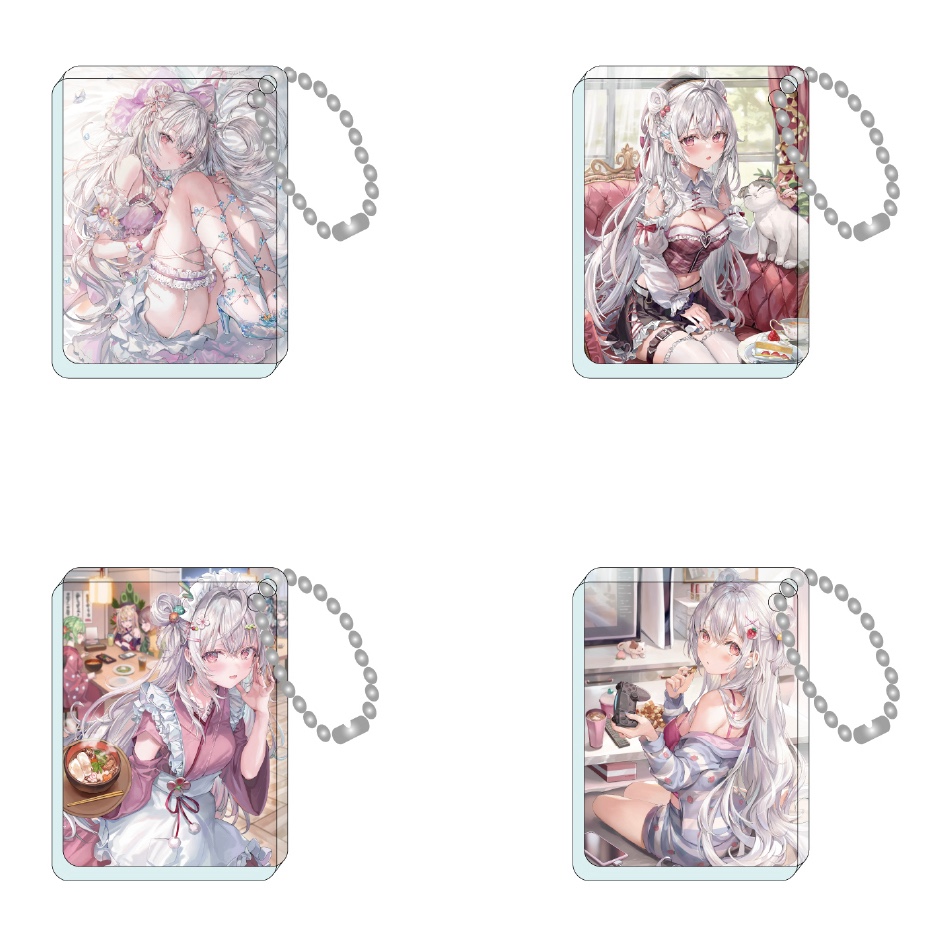ロシデレのアニメに刺激を受け、角度を変えた顔を練習するように。イラストレーター・ももこのこだわりと次に見据えるもの
インタビュー/原田イチボ
イラストレーター・ももこさんの個展「arpeggio」が、東京・表参道にある「pixiv WAEN GALLERY」にて2024年11月27日(水)まで開催中。11月18日(月)に発売予定の新作画集『arpeggio』(玄光社)の収録作と、イラストを担当する人気ライトノベル『時々ボソッとロシア語でデレる隣のアーリャさん』(KADOKAWA)の作品を中心とした展示です。

美術系の大学で油絵専攻だったという、ももこさん。繊細な光の表現へのこだわり、そしてロシデレのアニメ化から受けた影響などを教えていただきました。
美大在学中、美少女イラストに目覚める
── ももこさんは美術系の大学に通っていたそうですね。

子どもの頃から絵を描くのが好きで、女の子のイラストをずっと描いていました。初めは違う進路を選ぼうとしていたのですが、やっぱり自分は絵を描くのが好きだなぁと思い直して、絵画について学べる大学に進学しました。専攻は油絵です。
── いわゆる美少女イラストはずっと趣味で描いていたんですか?

いえ、美大進学を考える頃には、もうキャラクターのイラストは描かなくなって、大学でも花や物体ばかりを描いていました。
私、アニメやマンガがずっと好きだったんですが、家がちょっと厳しくて、あまり見させてもらえなかったんですよ。大学入学後にそういったコンテンツに自由に触れて、インターネットも使えるようになって、美少女イラストを目にする機会が増えました。その中で、「そういえば子どもの頃、女の子の絵をよく描いていたな」とキャラクター系のイラストを描くことへの興味が湧いてきました。
── ということは、デジタルで絵を描くようになったのは大学以降ですか?

はい。大学時代からパソコンで絵を描き始めました。だからイラストレーターとしては結構遅いほうだと思います。
── 大学卒業後はゲーム会社に就職し、デザインの仕事をしていたそうですね。

Photoshopの使い方を全然知らなかったので、仕事で叩き込まれて助かりました(笑)。
── そこから、どのようにフリーのイラストレーターに転身したのでしょうか?

印象派の絵画に影響を受けた
── ももこさんは過去のインタビューで、「影を塗るときに乗算レイヤーを使わず、ひとつひとつ色を選んでいる」と話していました。そのこだわりは今も変わっていませんか?

はい。乗算を使うと色の幅がなくなるように感じてしまって、自分の絵ではなるべく使いたくないと思っています。
── ももこさんの絵は、よく見ると輪郭線が1本でつながっていなかったりしますよね。

── 特に西洋絵画だと、輪郭線は描きませんしね。影の色をひとつずつ選んだり、輪郭線がラフだったり、ももこさんの絵は美麗でありながら、良い意味で、人間がこつこつ描いた「手仕事っぽさ」があると感じています。それは絵画をルーツにしているからこそのこだわりでしょうか?

そうだと思います。デジタル作画だとしても、自分の筆跡のようなものをなるべく残しておきたいんですよね。
── 絵画で、影響を受けた作品はありますか?

モネをはじめとした印象派の作品ですね。多彩な色を使ったうえで空気感まで表現しているところに惹かれました。
── キャラクター系のイラストで影響を受けた作品やクリエイターはいますか?

カントクさんです。女の子の表情など、私に足りないもの全部がそこに詰まっているように感じて、ずっと参考にしていました。
「描き込む/描き込まない」の判断
── イラストにおいて、全体を描き込みすぎると、逆にのっぺりした印象になりかねません。ももこさんの作品は精緻な描き込みが魅力ですが、「ここは描き込む/描き込まない」をどのように判断していますか?

一番見せたいところを強調するために、それ以外の部分はあえて描き込まないようにしています。描いている途中でいったん絵を遠ざけて見てみることは何度もしますし、ほかにも左右反転したり縮小してみたり……。ただまぁ「描き込む/描き込まない」は結構感覚で決めちゃっていますね。
何度も見比べてチェックしたいから、作業中はこまめに保存しています。上書きではなく、名前をつけて全部保存するから、ファイルがかさばってしかたない(笑)。── ももこさんの作品は、人物を際立たせるために、背景の書き込みはわりとラフだったりしますよね。繊細に描き込んだキャラクターとラフな背景を上手く調和させるコツはありますか?

── 植物や風景など、キャラクター以外の要素にもこだわりを感じさせます。「実はこれを描くのは苦手」というものはありますか?

── 意外! キャラの持ち物などの小道具、衣装の多彩さにも驚かされますが、どのようにインプットをしているのでしょうか?

ネットの画像をいろいろ見ているとき、服でも食べ物でも「なんかいいな」と感じたものはすぐ保存するようにしています。
何を考えているかわからない女の子を描くのが好き
── 繊細な光の表現が印象的ですが、ライティングはどの段階で決めているのでしょうか?

── ラフで全部決めるタイプなんですね。では、ラフには時間をかける?

── 描くスピードは速いほうですか?

── 背景ありでも、かなり速いほうに感じます……! ところで、これまでの作品を見ていて、ももこさんは女性キャラのお腹を描くのが好きなのかなと感じたのですが、実際いかがでしょうか?

めっちゃ好きです(笑)。ほかには腰回りとか手を描くのも好きですね。あとは顔の表情。
── 単純な喜怒哀楽に分けられない、いろいろな感情が混ざったような表情も多いですよね。

ロシデレのアニメ化で新たな発見
── イラストを担当されている「時々ボソッとロシア語でデレる隣のアーリャさん」シリーズ、通称ロシデレについても教えてください。描いていて楽しいキャラ、描くのが難しいキャラは誰ですか?

── イラストを担当した作品がアニメ化するのは、ロシデレが初めてですか?

はい。自分の絵が動くのを見て、いろいろな発見がありました。「動画にするうえで、こういうふうなデフォルメをするんだ」とか、「この角度の顔ってこうなるんだ」とか……。アニメを見ているうちに、もっといろんな角度からキャラを描けるようになりたいなと感じて、たまに練習するようになりました。
── いわゆる美少女イラストの分野では、キャラクターの顔がはっきり見える構図が主流ですもんね。

そうなんですよ。だから、斜め上とか斜め下とか、「照明をこの位置にしてみたらどうだろう」とか、普段描かない構図をいろいろ試しています。
── モチベーションが高い! スランプになることはありませんか?

── なるほど……。多忙なスケジュールの中で、時短への意識などはありますか?

── 自分では気になるけれど、他人からするとあまり気にならない部分に固執してしまっている時間ってありますよね。

個展のメインビジュアルに込めた「ベネチア愛」
── 今回の個展「arpeggio」のメインビジュアルと、11月18日(月)発売の新作画集の表紙は、どちらもベネチアの風景を描いたものですね。

── 個展のメインビジュアルで注目のポイントはどこですか?

ゴンドラに乗ってベネチアの運河を進んでいく動画を見て、「この洗濯物を干している風景を描いたら、おもしろいだろうな」と感じました。風を感じるイラストを描いてみたいなぁと。いつもはキャラを目立たせるために背景をぼかしがちなんですが、今回はしっかり背景を描くのに挑戦しました。建物の壁の古びた風合いなど、こだわって描いています。


── 個展の内装にもこだわっていると聞きました。


── グッズもいろいろ発売されます。特に楽しみなものは何ですか?

── 最新画集の見どころも教えてください。

初めての画集『arietta』(玄光社)から約5年間を経て、描き込みや色のセンスがだいぶ変わりました。イラストの繊細さがより増したんじゃないかな、と自負しています。描ける女の子のタイプも当時からずっと増えたので、ぜひチェックしてほしいです。
── 依頼を受けて描いた作品とオリジナルの作品、画集には両方が収録されていますが、今後どのようなバランスで活動していきたいですか?

半々でやっていくのが理想ですね。依頼ものは、自分が普段描かないものを描けるので勉強になるんですよ。大変だとしても必要な経験だと感じています。
── 最後に、今後挑戦したいことを教えてください。

3Dクリエイターの友達が増えたのと、ロシデレのアニメ化もあって、キャラを動かすことへの興味が強まっています。VTuberのデザインは何度か担当させていただきましたが、いつか3Dモデルを自分で作って動かすところまで挑戦してみたいです。また、たまに色鉛筆やコピックなどを使って趣味の絵を描いたりしているので、アナログで描いた作品の展示にも興味があります。あとは、「ベネチアに旅行に行く!」ですね(笑)。
11月27日(水)まで開催! ももこさん個展「arpeggio」
pixivとツインプラネットが共同運営するギャラリー「pixiv WAEN GALLERY」にてイラストレーター・ももこさんの個展「arpeggio」が2024年11月27日(水)まで開催中です。
新作画集『arpeggio』(玄光社)の収録作と、イラストを担当する人気ライトノベル『時々ボソッとロシア語でデレる隣のアーリャさん』(KADOKAWA)の作品を中心とした展示し、異国情緒あふれる展示空間を創り上げます。この機会にぜひ足をお運びください。
開催期間:2024年11月8日(金)〜11月27日(水)
入場無料
所在地:東京都渋谷区神宮前5-46-1 TWIN PLANET South BLDG. 1F
営業時間:12:00~19:00
一部グッズはWEB販売も!
BOOTHにて個展販売グッズの一部をご購入いただけます。ももこさんの美しいイラストをいかしたグッズが揃っています。ぜひご覧ください。
















